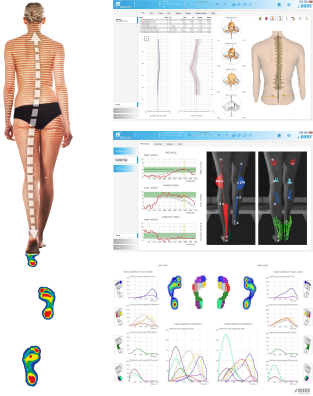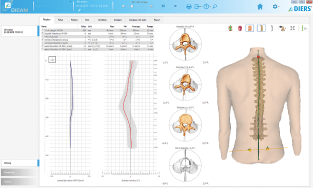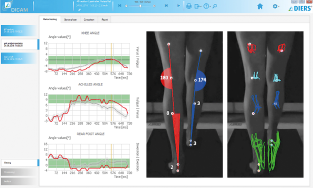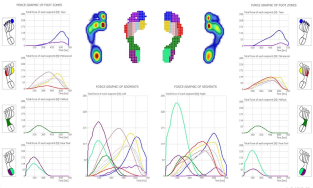Physically, one of the most important things in life is to be able to move freely and unimpaired. Yet most of us are not aware of the variety of muscles, joints and nerves which must work together in harmony to make coordinated movement possible. Even a slight disruption in this complex interaction can lead to serious movement constraints.
The source of the pain or discomfort is not always located where it is felt. For example, back pain and knee problems can be caused by issues with foot pressure or alignment, which in turn affects the entire body posture. For this reason it is necessary to measure the whole body in its entirety in order to obtain a reliable diagnosis.


The innovative DIERS 4D motion® measuring system is the first device capable of measuring the entire spine and posture while the patient is walking, and can therefore identify abnormalities in the gait pattern and determine the best treatment. It operates entirely radiation-free using light patterns. A light grid is projected on to the patient's back and recorded by a video camera. A unique software program then analyzes the line curvature and generates a three-dimensional model of the surface; creating a virtual plaster cast'. Through analysis of the surface curvature and detection of anatomical landmarks it is possible to reconstruct a dynamic 3D model of the entire spine.
Beyond that, the measuring system conveys valuable information on full body statics and posture while walking, e.g. curvature of the spine, rotation of the vertebrae, position of the pelvis and possible muscle imbalance.

Legs must carry body weight throughout an entire life. Walking considerably strains the hips, knees and feet. Imbalances, degeneration or injuries can seriously impair function and cause pain.
Even the slightest abnormalities in leg symmetry, i.e. posture and gait. With the aid of small adhesive markers applied to the legs, special recognition software recreates the structure of the leg axis and calculates the angles of the pelvis, knees and joints in the feet.
Pelvic tilt, gait imbalance, knee malalignement, fallen arches and other conditions can be clearly diagnosed which will make it possible to develop a custom pain treatment plan.

The physical condition of the feet strongly influences an individual's overall health and well-being. Knee and back problems, as well as headaches, frequently result from foot problems. The foot pressure measurement captures the reaction forces while walking using a pressure-sensitive measuring plate and special analytical software to illustrate the results-precise, conclusive information about all major factors which impact the function of the feet quickly obtained. With this technique even the slightest foot disorders can be identified and then corrected through optimal treatment, e.g. adaption of footwear, insoles, or physical therapy. The foot pressure measurement is not only applicable for the diagnosis of foot pain, but also for knee or leg pain, tendon or joint inflammation, as well as back pain or headaches which are influenced by the feet.
The physical condition of the feet strongly influences an individual's overall health and well-being. Knee and back problems, as well as headaches, frequently result from foot problems. The foot pressure measurement captures the reaction forces while walking using a pressure-sensitive measuring plate and special analytical software to illustrate the results-precise, conclusive information about all major factors which impact the function of the feet quickly obtained. With this technique even the slightest foot disorders can be identified and then corrected through optimal treatment, e.g. adaption of footwear, insoles, or physical therapy. The foot pressure measurement is not only applicable for the diagnosis of foot pain, but also for knee or leg pain, tendon or joint inflammation, as well as back pain or headaches which are influenced by the feet.
The DIERS functional musculoskeletal analysis system can be a useful tool for many different issues and concerns with spinal and back problems, joint issues, posture issues, and foot problems.
This can include Scoliosis, Hyper-/ Hypo-Lordosis /-Kyphosis, Pelvic Obliquity/Rotation/Torsion, posture-related Pain Symptoms, Temporomandibular Joint Dysfunction (TMJ), Osteoporosis, Arthrosis, Neurologic Symptoms (e.g. Romberg-Test), Muscle Deficits/Imbalances (Matthiass-Test, Flamingo Test) and more...
The therapist will request for you to get prepared for the scan by removing jewelery, etc., and will be offered a front torso drape for women in the case of a spinal measurement.
Depending on the type of scan, the therapist may need to place small light-reflecting markers onto necessary measuring points on the body. These are later easily removable by the patient after the scan is complete. Once prepared for scanning, the therapist will request you to step onto the scanning/measurement treadmill, and may adjust your foot positions for proper alignment for the scan. Depending on the type of scan being performed, it is possible that the scan will take place while simply standing on the treadmill, or while walking. The therapist will give guidance and feedback the entire duration of the scan.
As the scan is using a light-optical scanning method, the room will be slightly darkened to ensure the best scanning environment, and you as the patient will not feel anything at all. The scan is done entirely with light-technology, and does not take more than a few minutes to perform the actual scan and analysis, at which time it is complete.
It depends on which scan is being performed, but no shoes or jewelry can be worn during the scan itself. It is important for the right clothing to be worn during the analysis, or it can affect the quality of the results.
Foot Scans: no jewelry; leggings or shorts are recommended
Leg Scans: no jewelry; very short, form-fitting shorts, swimwear bottoms (if legs are free), or underwear
Spine Measurements: no jewelry; hair up and off of neck during scan; torso must be free/bare during scan itself (this means that no bra or sports bra can be worn and a chest-front drape will be offered for modesty purposes); no jeans, low-rise bottoms, leggings, or shorts are recommended
Yes. The DIERS functional musculoskeletal analysis system can be used ideally at the beginning, the middle, and at the end of therapy to track, record, and note progress, changes, and results seen throughout a patient’s physical therapy treatment.
MVZ Physiorehab Ramstein is proud of the good working relationship it has with insurances for Americans working and deployed overseas. This includes good communication between MVZ Physiorehab Ramstein and insurances about the state-of-the-art DIERS functional musculoskeletal analysis system and its reimbursement through insurances.
However, this is not a guarantee that your individual insurance plan will cover the costs. Currently, MVZ Physiorehab Ramstein has received the go-ahead from some insurances to direct bill for reimbursement, but we are still actively working to receive a finer-tuned answer as to a patient’s remaining out-of-pocket costs for treatment.
Monday - Thursday: 08:00 AM – 07:00 PM
Friday: 08:00 AM – 02:00 PM
Saturday: 08:00 AM – 02:00 PM
(appointment only)
Sunday: closed
Kindsbacher Str. 39D, 66877 Ramstein
+49 6371 95 20 408
www.mvz-physiorehab.com
